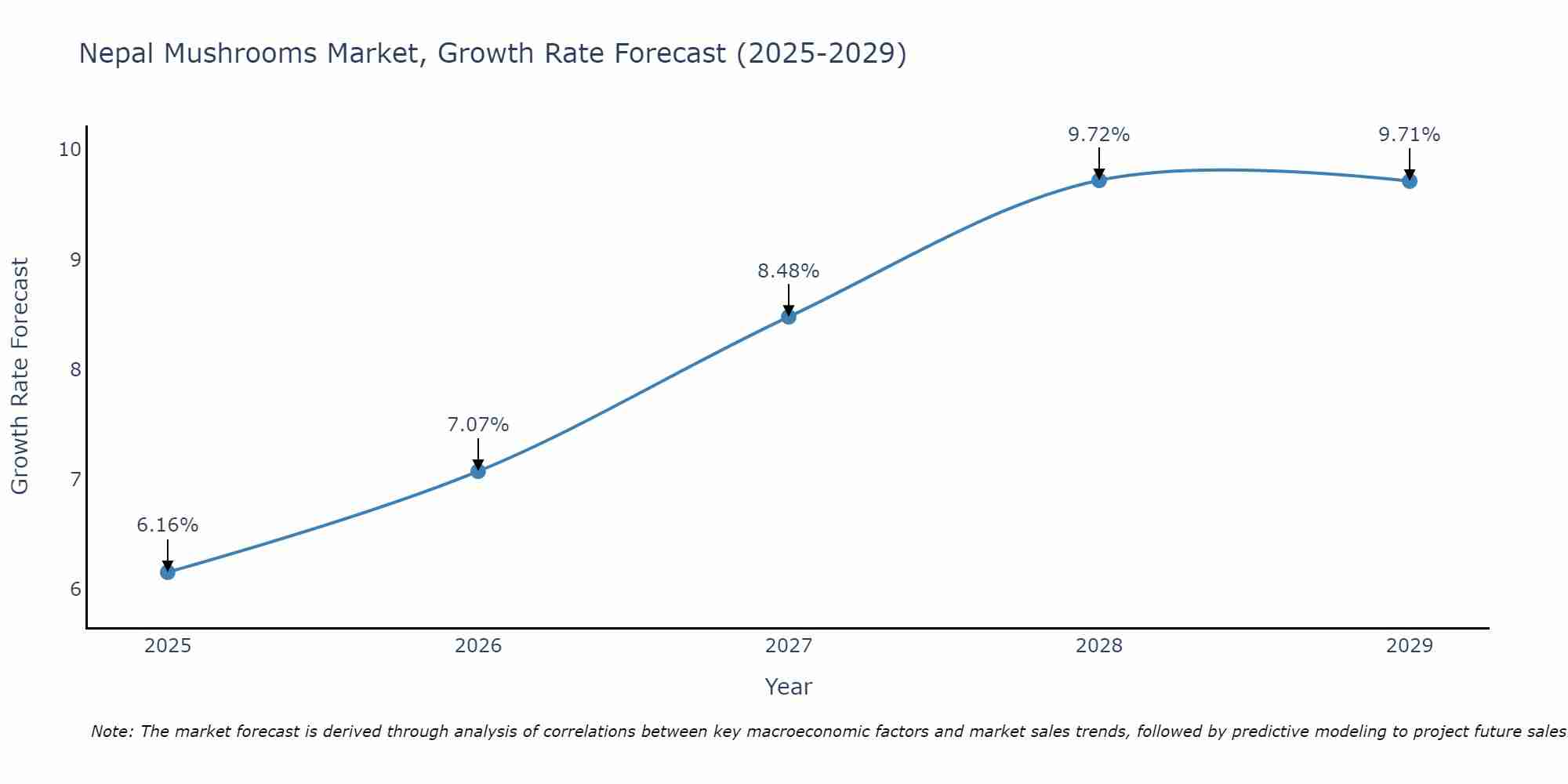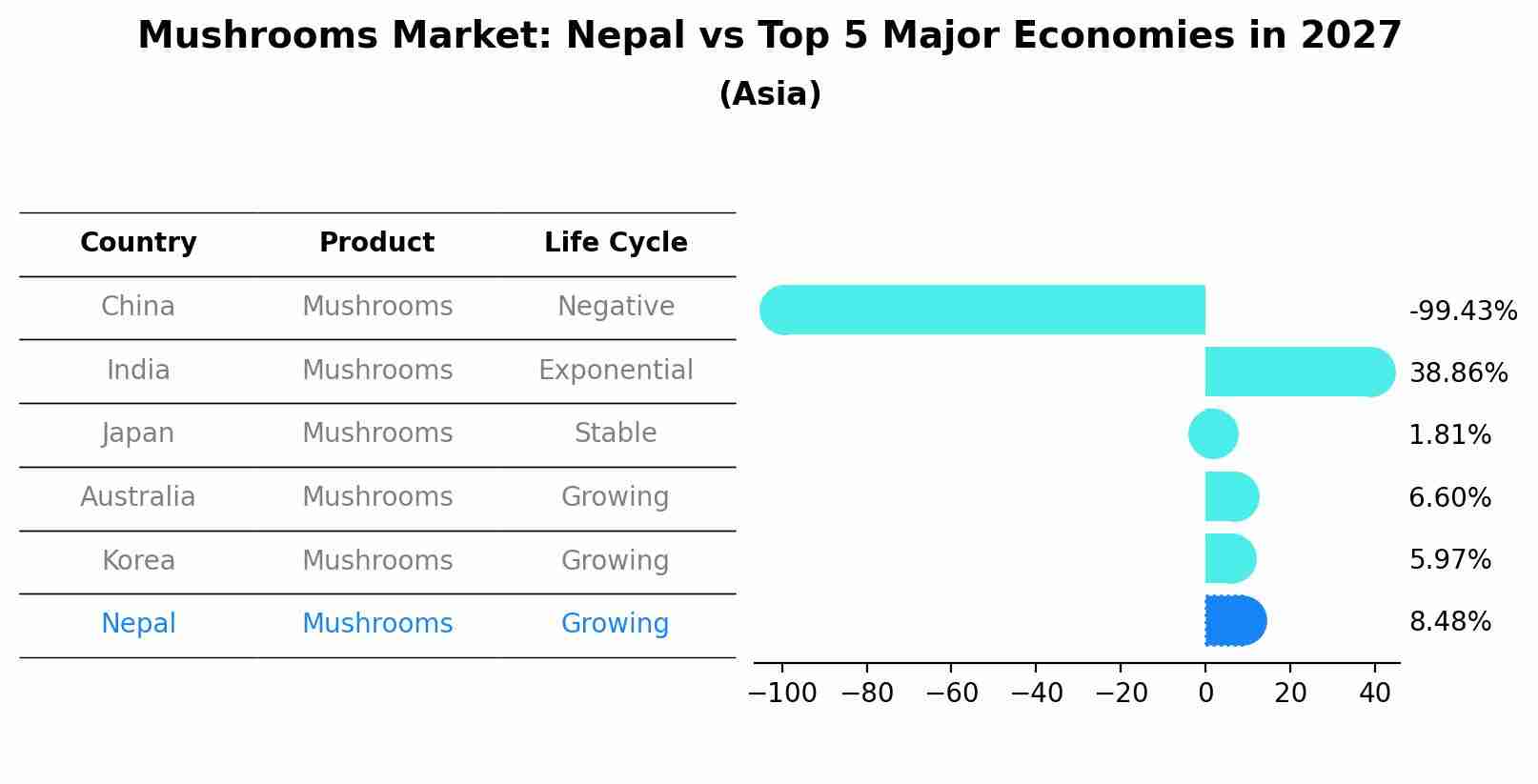Nepal Mushrooms Market (2025-2031) Outlook | Size, Analysis, Trends, Share, Growth, Revenue, Industry, Forecast, Companies & Value
| Product Code: ETC383196 | Publication Date: Aug 2022 | Updated Date: Jul 2025 | Product Type: Market Research Report | |
| Publisher: 6Wresearch | Author: Shubham Deep | No. of Pages: 75 | No. of Figures: 35 | No. of Tables: 20 |
Nepal Mushrooms Market Size Growth Rate
The Nepal Mushrooms Market is projected to witness mixed growth rate patterns during 2025 to 2029. Starting at 6.16% in 2025, the market peaks at 9.72% in 2028, and settles at 9.71% by 2029.

Mushrooms Market: Nepal vs Top 5 Major Economies in 2027 (Asia)
The Mushrooms market in Nepal is projected to grow at a growing growth rate of 8.48% by 2027, highlighting the country's increasing focus on advanced technologies within the Asia region, where China holds the dominant position, followed closely by India, Japan, Australia and South Korea, shaping overall regional demand.

Nepal Mushrooms Market Synopsis
The Nepal mushrooms market is experiencing steady growth driven by increasing consumer awareness of the nutritional benefits and culinary versatility of mushrooms. Oyster mushrooms are the most commonly cultivated variety in Nepal, with significant production in districts like Kavrepalanchok and Dhading. The market is predominantly driven by domestic consumption, with mushrooms being a popular ingredient in traditional Nepali dishes. However, there is also a growing trend towards commercial cultivation and export opportunities, particularly for high-value varieties like Shiitake and Button mushrooms. Challenges such as limited technical knowledge, infrastructure constraints, and inconsistent quality standards exist but present opportunities for market players to innovate and improve production practices. Overall, the Nepal mushrooms market shows promising potential for expansion and diversification in the coming years.
Nepal Mushrooms Market Trends
The Nepal mushrooms market is witnessing a growing demand for exotic and specialty mushroom varieties such as oyster, shiitake, and enoki due to their unique flavors and health benefits. Consumers are increasingly seeking out organic and locally sourced mushrooms, driving the market towards sustainable and environmentally friendly practices. There is a rising interest in mushroom cultivation as a sustainable source of income for farmers, leading to the expansion of small-scale mushroom farms across the country. Additionally, the awareness of the nutritional value and medicinal properties of mushrooms is contributing to their popularity among health-conscious consumers. Overall, the Nepal mushrooms market is experiencing a shift towards premium, high-quality products that cater to the diverse preferences of consumers.
Nepal Mushrooms Market Challenges
In the Nepal mushrooms market, some challenges include inconsistent supply due to dependency on weather conditions for mushroom cultivation, lack of awareness and education among farmers regarding modern cultivation techniques and practices, limited access to quality inputs such as spawn and substrate, inadequate infrastructure for post-harvest handling and storage, and limited market linkages for small-scale mushroom farmers to reach wider consumer bases. Additionally, there is also competition from imported mushrooms in the market, which can affect the pricing and demand for locally grown varieties. Overcoming these challenges would require investments in training and capacity building for farmers, improving infrastructure and logistics, enhancing market linkages, and promoting domestic mushroom consumption to reduce reliance on imports.
Nepal Mushrooms Market Investment Opportunities
The Nepal mushrooms market presents various investment opportunities due to a growing demand for mushrooms as a healthy and sustainable food option. Investors can consider opportunities in mushroom cultivation, processing, and distribution. With favorable climatic conditions and a rich biodiversity, Nepal has the potential to produce a variety of mushroom species including oyster, shiitake, and button mushrooms. Investing in modern cultivation techniques, quality control measures, and value-added products can help capitalize on the increasing consumer interest in mushrooms. Additionally, promoting awareness about the nutritional benefits of mushrooms and exploring export opportunities can further enhance the growth prospects in the Nepal mushrooms market. Overall, investing in the mushroom industry in Nepal offers potential for profitability and sustainable business growth.
Jordan Agar Market Government Policies
Government policies related to the Nepal mushrooms market include the promotion of mushroom cultivation through various subsidies and incentives to increase production and export potential. The government has also implemented regulations to ensure food safety standards and quality control in the mushroom industry. Additionally, efforts have been made to provide training and technical support to farmers to improve their cultivation practices and increase productivity. Overall, the government is actively supporting the growth of the mushrooms market in Nepal through policy initiatives aimed at boosting production, ensuring quality, and enhancing competitiveness both domestically and internationally.
Nepal Mushrooms Market Future Outlook
The future outlook for the Nepal mushrooms market appears promising as the demand for mushrooms continues to grow due to increasing awareness of their health benefits and versatility in culinary applications. With a rich tradition of mushroom cultivation in Nepal and favorable climatic conditions for mushroom production, the market is expected to expand further in the coming years. Additionally, the rising popularity of exotic and specialty mushrooms among consumers offers opportunities for diversification and premiumization within the market. Government initiatives to promote mushroom cultivation and support for small-scale farmers are also contributing to the market`s growth potential. Overall, the Nepal mushrooms market is poised for steady growth driven by evolving consumer preferences and supportive policies.
Key Highlights of the Report:
- Nepal Mushrooms Market Outlook
- Market Size of Nepal Mushrooms Market, 2024
- Forecast of Nepal Mushrooms Market, 2031
- Historical Data and Forecast of Nepal Mushrooms Revenues & Volume for the Period 2021 - 2031
- Nepal Mushrooms Market Trend Evolution
- Nepal Mushrooms Market Drivers and Challenges
- Nepal Mushrooms Price Trends
- Nepal Mushrooms Porter's Five Forces
- Nepal Mushrooms Industry Life Cycle
- Historical Data and Forecast of Nepal Mushrooms Market Revenues & Volume By Product for the Period 2021 - 2031
- Historical Data and Forecast of Nepal Mushrooms Market Revenues & Volume By Button for the Period 2021 - 2031
- Historical Data and Forecast of Nepal Mushrooms Market Revenues & Volume By Shiitake for the Period 2021 - 2031
- Historical Data and Forecast of Nepal Mushrooms Market Revenues & Volume By Oyster for the Period 2021 - 2031
- Historical Data and Forecast of Nepal Mushrooms Market Revenues & Volume By Matsutake for the Period 2021 - 2031
- Historical Data and Forecast of Nepal Mushrooms Market Revenues & Volume By Truffles for the Period 2021 - 2031
- Historical Data and Forecast of Nepal Mushrooms Market Revenues & Volume By Other for the Period 2021 - 2031
- Historical Data and Forecast of Nepal Mushrooms Market Revenues & Volume By Form for the Period 2021 - 2031
- Historical Data and Forecast of Nepal Mushrooms Market Revenues & Volume By Fresh for the Period 2021 - 2031
- Historical Data and Forecast of Nepal Mushrooms Market Revenues & Volume By Processed for the Period 2021 - 2031
- Historical Data and Forecast of Nepal Mushrooms Market Revenues & Volume By Distribution Channel for the Period 2021 - 2031
- Historical Data and Forecast of Nepal Mushrooms Market Revenues & Volume By Direct to Customer for the Period 2021 - 2031
- Historical Data and Forecast of Nepal Mushrooms Market Revenues & Volume By Grocery Stores for the Period 2021 - 2031
- Historical Data and Forecast of Nepal Mushrooms Market Revenues & Volume By Supermarkets & Hypermarkets for the Period 2021 - 2031
- Historical Data and Forecast of Nepal Mushrooms Market Revenues & Volume By Convenience Stores for the Period 2021 - 2031
- Historical Data and Forecast of Nepal Mushrooms Market Revenues & Volume By Online Stores for the Period 2021 - 2031
- Historical Data and Forecast of Nepal Mushrooms Market Revenues & Volume By Application for the Period 2021 - 2031
- Historical Data and Forecast of Nepal Mushrooms Market Revenues & Volume By Food for the Period 2021 - 2031
- Historical Data and Forecast of Nepal Mushrooms Market Revenues & Volume By Pharmaceutical for the Period 2021 - 2031
- Historical Data and Forecast of Nepal Mushrooms Market Revenues & Volume By Cosmetics for the Period 2021 - 2031
- Nepal Mushrooms Import Export Trade Statistics
- Market Opportunity Assessment By Product
- Market Opportunity Assessment By Form
- Market Opportunity Assessment By Distribution Channel
- Market Opportunity Assessment By Application
- Nepal Mushrooms Top Companies Market Share
- Nepal Mushrooms Competitive Benchmarking By Technical and Operational Parameters
- Nepal Mushrooms Company Profiles
- Nepal Mushrooms Key Strategic Recommendations
Frequently Asked Questions About the Market Study (FAQs):
- Single User License$ 1,995
- Department License$ 2,400
- Site License$ 3,120
- Global License$ 3,795
Search
Related Reports
- Portugal Electronic Document Management Market (2025-2031) | Strategy, Consumer Insights, Analysis, Investment Trends, Opportunities, Growth, Size, Share, Industry, Revenue, Segments, Value, Segmentation, Supply, Forecast, Restraints, Outlook, Competition, Drivers, Trends, Demand, Pricing Analysis, Competitive, Strategic Insights, Companies, Challenges
- France Electronic Document Management Market (2025-2031) | Strategy, Consumer Insights, Analysis, Investment Trends, Opportunities, Growth, Size, Share, Industry, Revenue, Segments, Value, Segmentation, Supply, Forecast, Restraints, Outlook, Competition, Drivers, Trends, Demand, Pricing Analysis, Competitive, Strategic Insights, Companies, Challenges
- Portugal Occupational Health & Safety Services Market (2025-2031) | Strategy, Consumer Insights, Analysis, Investment Trends, Opportunities, Growth, Size, Share, Industry, Revenue, Segments, Value, Segmentation, Supply, Forecast, Restraints, Outlook, Competition, Drivers, Trends, Demand, Pricing Analysis, Competitive, Strategic Insights, Companies, Challenges
- Netherlands Occupational Health and Safety Services Market (2025-2031) | Strategy, Consumer Insights, Analysis, Investment Trends, Opportunities, Growth, Size, Share, Industry, Revenue, Segments, Value, Segmentation, Supply, Forecast, Restraints, Outlook, Competition, Drivers, Trends, Demand, Pricing Analysis, Competitive, Strategic Insights, Companies, Challenges
- Belgium and Luxembourg Facility Management Market (2025-2031) | Strategy, Consumer Insights, Analysis, Investment Trends, Opportunities, Growth, Size, Share, Industry, Revenue, Segments, Value, Segmentation, Supply, Forecast, Restraints, Outlook, Competition, Drivers, Trends, Demand, Pricing Analysis, Competitive, Strategic Insights, Companies, Challenges
- Russia Women Intimate Apparel Market (2025-2031) | Strategy, Consumer Insights, Analysis, Investment Trends, Opportunities, Growth, Size, Share, Industry, Revenue, Segments, Value, Segmentation, Supply, Forecast, Restraints, Outlook, Competition, Drivers, Trends, Demand, Pricing Analysis, Competitive, Strategic Insights, Companies, Challenges
- Africa Chocolate Market (2025-2031) | Size, Share, Trends, Growth, Revenue, Analysis, Forecast, industry & Outlook
- Global Hydroxychloroquine And Chloroquine Market (2025-2031) | Industry, Trends, Size, Outlook, Growth, Value, Companies, Revenue, Analysis, Share, Forecast
- Saudi Arabia Plant Maintenance Market (2025-2031) | Industry, Size, Growth, Revenue, Value, Companies, Forecast, Analysis, Share & Trends
- Taiwan Electric Truck Market (2025-2031) | Outlook, Industry, Revenue, Size, Forecast, Growth, Analysis, Share, Companies, Value & Trends
Industry Events and Analyst Meet
Our Clients
Whitepaper
- Middle East & Africa Commercial Security Market Click here to view more.
- Middle East & Africa Fire Safety Systems & Equipment Market Click here to view more.
- GCC Drone Market Click here to view more.
- Middle East Lighting Fixture Market Click here to view more.
- GCC Physical & Perimeter Security Market Click here to view more.
6WResearch In News
- Doha a strategic location for EV manufacturing hub: IPA Qatar
- Demand for luxury TVs surging in the GCC, says Samsung
- Empowering Growth: The Thriving Journey of Bangladesh’s Cable Industry
- Demand for luxury TVs surging in the GCC, says Samsung
- Video call with a traditional healer? Once unthinkable, it’s now common in South Africa
- Intelligent Buildings To Smooth GCC’s Path To Net Zero













